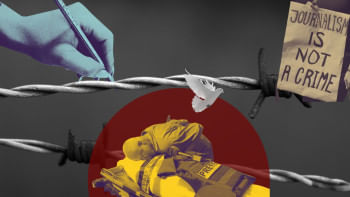Combating disinformation is key to restoring trust in journalism

We observe World Press Freedom Day at a time when the transformation of technology has severely disrupted the notion and purpose of many things, including the press. While many, including myself, find comfort in reading the hard copy of the newspaper in the morning, and enjoy the distinct scent of the paper fresh off the press, technology is progressively changing the course by shifting news from print to digital devices.
The dissemination of news has never been faster and more multi-modal than it is today. The content and reliability of news have also never been this questionable. Thanks to the advent of artificial intelligence and general-purpose technologies (GPT) as well as the range of platforms, the disruption of technology has blurred the lines of what constitutes press, and therefore press freedom.
We are seeing a surge of propaganda and information war on social media platforms. Since the assumption of the interim government, some Indian mainstream media, bots, influencers, and users on social media platforms have waged a concerted disinformation campaign against Bangladesh. This includes false information about Bangladesh's economy, military coup, atrocities against the Hindu religious minority. The CA Press Wing Facts, the fact-checking arm of the chief adviser's press wing, countered those narratives with facts on behalf of the government. Research by the Tech Global Institute finds that Google prioritised Indian sources on specific topics about Bangladesh, whereas credible reports from leading Bangladeshi media outlets were buried at least under a dozen pages. The algorithmic bias on social media platforms and search engines escalated those disinformation contents.
The Indian disinformation campaign undermines not only the journalistic integrity of that country's media, but also strains the relationship between the two countries by way of promoting hatred. This has serious implications on Bangladesh's national security as well.
This is where press freedom must be protected against the enablers of disinformation. We are in an era where the transformation of technology requires reimagination of governance frameworks. In the United States, Section 230 of the Communications Decency Act protects platforms of intermediary responsibility behind the atrocities that Facebook has enabled against the Rohingya. Two decades ago, this provision was in line with the First Amendment rights. Today, human rights advocates are concerned about whether this immunity is the best approach to protecting free speech.
Now, what does Facebook have to do with press freedom? In January, the White House decided to invite social media influencers alongside journalists to attend its press briefings. There are precedents of independent journalists doing exceptionally well in alternative and digital media, whereas Fox has demonstrated right-wing propaganda in the traditional media. Yet, diluting the role of journalists by having social media influencers relay the White House messages warrants a concern about opening the sluice gate for narratives that, in other words, amount to mis- and disinformation.
This requires a robust response—one that draws a clear distinction between press freedom and crackdown on disinformation. The European External Action Service (EEAS) has developed Foreign Information Manipulation and Interference (FIMI) as a policy framework to combat disinformation and manipulative behaviour. The framework has four pillars: situational awareness; resilience building; disruption and regulation; and EU external action. Each of these pillars have a multi-layered approach.
At a time when Meta has decided to dismantle its fact-checking capability, and the company's founder Mark Zuckerberg admits that they "are going to catch less bad stuff," it is important that press freedom and the right to freedom of expression are not exploited to cater to disinformation.
The traditional approach to addressing disinformation has been robust dissemination of accurate information. But this approach faces a significant challenge when confronted against industrialised disinformation campaigns. Individuals and independent institutions don't have the resources and capacity alone to counter disinformation when produced at scale.
States, therefore, require a multi-pronged approach to assess threats and risks from disinformation, and to measure it against the international human rights law to ensure that any action initiated by the authorities are necessary, proportionate and legitimate, that all other means have been exhausted in a transparent and systematic manner, before any restrictive or punitive measures are applied.
A systematic approach to address and contain disinformation under the FIMI framework comprises open-source intelligence and impact assessment of the content as part of situational awareness. The content is then weighed against resilience-building measures such as fact-checking, capacity-building of institutions that can produce reliable news and counter false narratives, digital media and information literacy, and strategic communications.
A fundamental element of combating disinformation is having the right set of disruptive and regulatory framework that holds platforms accountable for the services they offer. Human rights groups welcomed the EU's Digital Services Act introduced last year to hold Big Tech accountable to protect human rights. These measures are critical to combat the industry-scale information operations or the disinformation machinery that some political parties and states patronise.
The EU's FIMI framework further consists of external actions that include restrictive measures, diplomatic responses, and multilateral cooperation, as well as the exercise of international norms and principles. At a recent discussion by an EU diplomat that I attended, I raised the question about how the EU draws distinction between combating disinformation and upholding media freedom. My takeaway from that discussion is that the laws such as the Digital Services Act and the Artificial Intelligence (AI) Act of the EU don't target what somebody says. Instead, they promote transparency. The AI Act, for example, divides services into four categories, starting from no-risk to high-risk. The high-risk services are considered unsuitable and therefore not allowed to operate. The risk-based approach does not put everybody under the same regulatory pressure.
Press freedom must be protected not only from repressive pieces of legislation, but also from the concerted disinformation that some platforms and actors patronise under the refuge of free speech.
Saad Hammadi is policy and advocacy manager and a fellow at the Balsillie School of International Affairs in Canada.
Views expressed in this article are the author's own.
Follow The Daily Star Opinion on Facebook for the latest opinions, commentaries, and analyses by experts and professionals. To contribute your article or letter to The Daily Star Opinion, see our submission guidelines.

 For all latest news, follow The Daily Star's Google News channel.
For all latest news, follow The Daily Star's Google News channel. 












Comments